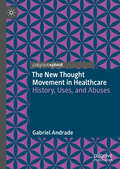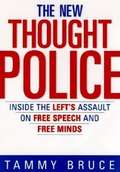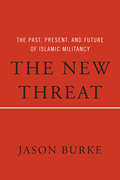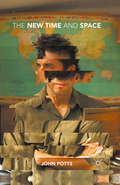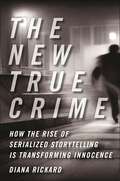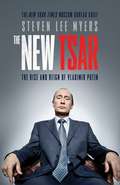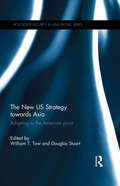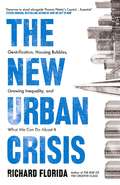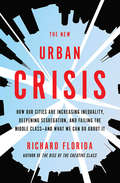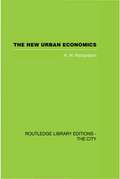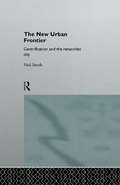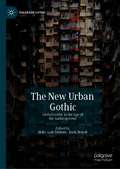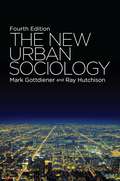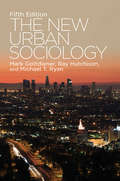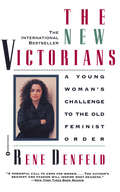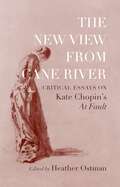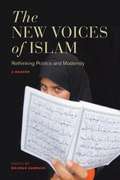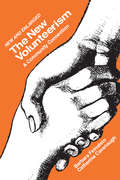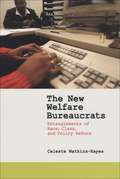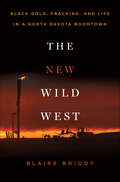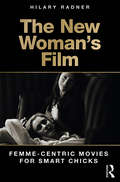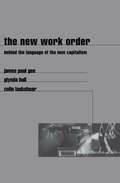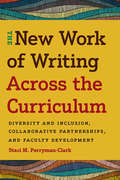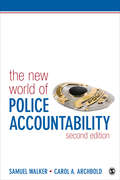- Table View
- List View
The New Thought Movement in Healthcare: History, Uses, and Abuses
by Gabriel AndradeThis book delves into the evolution of the New Thought Movement and its pervasive influence on modern healthcare. The book begins by tracing the roots of the New Thought Movement, originating in the 19th century, emphasizing the power of the mind in healing and personal development. Over time, this philosophy morphed into the contemporary positive thinking industry, becoming a significant component of Western self-help culture. The book explores how these ideas have become a contentious point in today's culture wars, polarized between supporters who credit it for personal empowerment and critics who highlight its limitations and potential harm. Central to the discussion is an in-depth analysis of the New Thought philosophy's impact on the healthcare industry. While acknowledging the potential benefits, such as motivating patients to adopt healthier lifestyles and fostering a sense of personal agency, the book critically examines how this philosophy's emphasis on mental positivity can lead to victim-blaming. It argues that oversimplifying health issues by attributing them solely to personal mindset obscures the multifaceted reality of health, particularly the significant role of social determinants of health and systemic inequities. This critique underscores how attributing illness to insufficient positive thinking can perpetuate stigma and neglect the socio-economic and environmental factors critical for understanding and addressing health challenges. By offering a nuanced perspective, the book aims to catalyze discussions on integrating mindful optimism with a holistic acknowledgment of the complexities inherent in healthcare, striving for a more balanced and equitable approach
The New Thought Police: Inside the Left's Assault on Free Speech and Free Minds
by Tammy BruceAn openly gay, pro-choice, gun-owning, pro-death-penalty, liberal feminist who voted for Reagan, Bruce was elected president of the Los Angeles chapter of the National Organization of Women in 1990. She accuses the Left of perpetual victimhood, thought and speech control to hold onto their power, and calling in the cops to squash any dissent.
The New Threat
by Jason BurkeJason Burke is one of the world's leading experts on militant Islam. He embedded with the Kurdish peshmerga (currently at war with ISIS) while still in college. He was hanging out with the Taliban in the late 1990s. He witnessed the bombing of Tora Bora in Afghanistan in 2001 firsthand.With the current emergence of ISIS in Iraq and Syria and the resurgence of the Taliban in Afghanistan and Pakistan, no one is as well placed as Burke-whose previous books have been chosen as books of the year by The Economist, the Daily Telegraph, and The Independent-to explain this dramatic post-Al Qaeda phase of Islamic militancy. We are now, he argues, entering a new phase of radical violence that is very different from what has gone before, one that is going to redefine the West's relationship with terrorism and the Middle East.ISIS is not "medieval," as many U.S. national security pundits claim, but, Burke explains, a group whose spectacular acts of terror are a contemporary expression of our highly digitized societies, designed to generate global publicity. In his account, radical Islamic terrorism is not an aberration or "cancer," as some politicians assert; it is an organic part of the modern world. This book will challenge the preconceptions of many American readers and will be hotly debated in national security circles.
The New Time and Space
by John PottsIn the networked age, we are living with changed parameters of time and space. Mobile networked communication fosters a form of virtual time and space, which is super-imposed onto territorial space. Time is increasingly composed of interruptions and distractions, as smartphone users are overwhelmed by messages.
The New True Crime: How the Rise of Serialized Storytelling Is Transforming Innocence (Alternative Criminology)
by Diana RickardHow serialized crime shows became an American obsessionTV shows and podcasts like Making a Murderer, Serial, and Atlanta Monster have taken the cultural zeitgeist by storm, and contributed to the release of wrongly imprisoned people—such as Adnan Syed. The popularity of these long-form true crime docuseries has sparked greater attention to issues of inequality, power, social class, and structural racism. More and more, the American public is asking, Who is and is not deserving of punishment, and who is and is not protected by the law? In The New True Crime, Diana Rickard argues that these new true crime series deserve our attention for what they reveal about our societal understanding of crime and punishment, and for the new light they shine on the inequalities of the criminal justice system. Questioning the finality of verdicts, framing facts as in the eye of the beholder—these new series unmoor our faith in what is knowable, even as, Rickard critically notes, they often blur the lines between “fact” and “fiction.”With a focus on some of the most popular true crime podcasts and streaming series of the last decade, Rickard provides an in-depth analysis of the ways in which this new media—which allows for binge-listening or watching—makes crime into a public spectacle and conveys ideological messages about punishment to its audience. Entertainment values have always been entwined with crime news reporting. Newsworthy stories, Rickard reminds us, need to involve sex, violence, or a famous person, and contain events that can be framed in terms of individualism and conservative ideologies about crime. Even as these old tropes of innocent victims and deviant bad guys still dominate these docuseries, Rickard also unpacks how the new true crime has been influenced by the innocence movement, a diverse group of organizers and activists, be they journalists, lawyers, formerly incarcerated people, or family members, who now have a place in mainstream consciousness as DNA evidence exonerates the wrongly convicted.The New True Crime questions the knowability of truth and probes our anxieties about the “real” nature of true crime media. For fans of true crime shows and anyone concerned about justice in America, this book will prove to be essential reading.
The New Tsar
by Steven Lee MyersAn epic tale of Vladimir Putin's path to power, as he emerged from obscurity to become one of the world's most conflicted and important leaders. Former New York Times Moscow Bureau Chief Steven Lee Myers has followed Putin since well before the recent events in the Ukraine, and gives us the fullest and most engaging account available of his rise to power. A gripping, page-turning narrative about Russian power and prestige, the book depicts a cool and calculating leader with enormous ambition and few scruples. As the world struggles to confront a newly assertive Russia, the importance of understanding Putin has never been greater. Vladimir Putin rose out of Soviet deprivation to the pinnacle of influence in the new Russian nation. He came to office in 2000 as a reformer, cutting taxes and expanding property rights, bringing a measure of order and eventually prosperity to millions whose only experience of democracy in the early years following the Soviet collapse was instability, poverty and criminality. But soon Putin orchestrated the preservation of a new kind of authoritarianism, consolidating power, reasserting his country's might, brutally crushing revolts and swiftly dispatching dissenters, even as he retained the support of many.
The New US Strategy towards Asia: Adapting to the American Pivot (Routledge Security in Asia Pacific Series)
by Douglas Stuart William T TowBarack Obama’s "rebalancing" or "pivot" strategy, intended to demonstrate continued US commitment to the Asia-Pacific region in a variety of military, economic, and diplomatic contexts, was launched with much fanfare in 2011. Implicit in the new strategy is both a focus on China – engagement with, and containment of – and a heavy reliance by the United States on its existing friends and allies in the region in order to implement its strategy. This book explores the impact of the new strategy on America’s regional friends and allies. It shows how these governments are working with Washington to advance and protect their distinct national interests, while at the same time avoiding any direct confrontation with China. It also addresses the reasons why many of these regional actors harbour concerns about the ability of the US to sustain the pivot strategy in the long run. Overall, the book illustrates the deep complexities of the United States’ exercise of power and influence in the region.
The New Urban Crisis: Gentrification, Housing Bubbles, Growing Inequality, and What We Can Do About It
by Richard FloridaNever before have our cities been as important as they are now. The drivers of innovation and growth, they are essential to the prosperity of nations. But they are also destructive, plunging us into housing crises and deepening inequality. How can we keep the good and break free of the bad? In this bracingly original work of research and analysis, leading urbanist Richard Florida explores the roots of this new crisis and puts forward a plan to make this the century of the fairer, thriving metropolis.
The New Urban Crisis: How Our Cities Are Increasing Inequality, Deepening Segregation, and Failing the Middle Classand What We Can Do About It
by Richard FloridaIn recent years, the young, educated, and affluent have surged back into cities, reversing decades of suburban flight and urban decline. And yet all is not well, Richard Florida argues in The New Urban Crisis. Florida, one of the first scholars to anticipate this back-to-the-city movement in his groundbreaking The Rise of the Creative Class, demonstrates how the same forces that power the growth of the world's superstar cities also generate their vexing challenges: gentrification, unaffordability, segregation, and inequality. Meanwhile, many more cities still stagnate, and middle-class neighborhoods everywhere are disappearing. Our winner-take-all cities are just one manifestation of a profound crisis in today's urbanized knowledge economy. A bracingly original work of research and analysis, The New Urban Crisis offers a compelling diagnosis of our economic ills and a bold prescription for more inclusive cities capable of ensuring growth and prosperity for all.
The New Urban Frontier: Gentrification and the Revanchist City
by Neil SmithWhy have so many central and inner cities in Europe, North America and Australia been so radically revamped in the last three decades, converting urban decay into new chic? Will the process continue in the twenty-first century or has it ended? What does this mean for the people who live there? Can they do anything about it? This book challenges conventional wisdom, which holds gentrification to be the simple outcome of new middle-class tastes and a demand for urban living. It reveals gentrification as part of a much larger shift in the political economy and culture of the late twentieth century. Documenting in gritty detail the conflicts that gentrification brings to the new urban 'frontiers', the author explores the interconnections of urban policy, patterns of investment, eviction, and homelessness. The failure of liberal urban policy and the end of the 1980s financial boom have made the end-of-the-century city a darker and more dangerous place. Public policy and the private market are conspiring against minorities, working people, the poor, and the homeless as never before. In the emerging revanchist city, gentrification has become part of this policy of revenge.
The New Urban Gothic: Global Gothic in the Age of the Anthropocene (Palgrave Gothic)
by Ruth Heholt Holly-Gale MilletteThis collection explores global dystopic, grotesque and retold narratives of degeneration, ecological and economic ruin, dystopia, and inequality in contemporary fictions set in the urban space. Divided into three sections—Identities and Histories, Ruin and Residue, and Global Gothic—The New Urban Gothic explores our anxieties and preoccupation with social inequalities, precarity and the peripheral that are found in so many new fictions across various media. Focusing on non-canonical Gothic global cities, this distinctive collection discusses urban centres in England’s Black Country, Moscow, Detroit, Seoul, Hong Kong, Bangkok, Singapore, Dehli, Srinigar, Shanghai and Barcelona as well as cities of the imaginary, the digital and the animated. This book will appeal to anyone interested in the intersections of time, place, space and media in contemporary Gothic Studies. The New Urban Gothic casts reflections and shadows on the age of the Anthropocene.
The New Urban Sociology
by Ray Hutchison Mark GottdienerGottdiener (sociology, State U. of New York-Buffalo) in the 1994 first edition, with Hutchison (urban and regional studies, U. of Wisconsin-Green Bay), offer a paradigm of urban ecology based on an economy and political system hegemonically controlled by large, powerful interests that move to make their concerns the most important in the mixed economy where government intervention usually favors those powerful interests. The approach is still new, they say, because there remain individuals and schools promulgating the old view that multiple buyers and sellers reign supreme, and promoting neo-liberal political and planning prescriptions that weight market solutions heavily despite government subsidies. Their textbook discusses such topics as the origins of urban life, the rise of urban sociology, urbanization in the US, people and lifestyles in the metropolis, metropolitan problems, urbanization in the developed nations and in the developing world, metropolitan planning and environmental issues, and the future of urban sociology. Annotation ©2010 Book News, Inc. , Portland, OR (booknews. com)
The New Urban Sociology
by Ray Hutchison Mark GottdienerOrganized around an integrated paradigm-the sociospatial perspective-this breakthrough text considers the role played by social factors such as race, class, gender, lifestyle, economics, culture, and politics on the development of metropolitan areas. By moving beyond the traditional city/suburb dichotomy, the authors' unique focus on the continuously changing nature of metropolitan regions makes the material more relevant to students' personal experiences, and the cohesive conceptual framework engages students' critical thinking skills. It integrates the social ecological with the political economy paradigm through a fresh theoretical approach emphasizing the importance of space to social life and real estate to the economy and urban development. Fully revised throughout, this edition features a new chapter on metropolitan social policy and expanded discussions of international regions, key concepts, and the effect of the economic crisis on housing markets, public policy, and urban development. Concise and accessible, this book offers students a brief, intelligible history of urban life from its origins to the industrial period, as well as a clear, sophisticated summary of urban social theory.
The New Urban Sociology: Fourth Edition
by Ray Hutchison Mark Gottdiener Michael T. RyanWidely recognized as a groundbreaking text, The New Urban Sociology is a broad and expert introduction to urban sociology that is both relevant and accessible to the student. A thought leader in the field, the book is organized around an integrated paradigm?the sociospatial perspective?which considers the role played by social factors such as race, class, gender, lifestyle, economics, culture, and politics on the development of metropolitan areas. Emphasizing the importance of space to social life and real estate to urban development, the book integrates social, ecological and political economy perspectives and research through a fresh theoretical approach. With its unique perspective, concise history of urban life, clear summary of urban social theory, and attention to the impact of culture on urban development, this book gives students a cohesive conceptual framework for understanding cities and urban life.In this thoroughly revised 5th edition, authors Mark Gottdiener, Ray Hutchison, and Michael T. Ryan offer expanded discussions of created cultures, gentrification, and urban tourism, and have incorporated the most recent work in the field throughout the text. The New Urban Sociology is a necessity for all courses on the subject.
The New Victorians: A Young Woman's Challenge to the Old Feminist Order
by Rene DenfeldJournalist Rene Denfeld explains why her generation has become alienated from the women's movement, maintaining that the actions of the movement's current leadership have actually encouraged a return to the kind of sexual repression and political powerlessness challenged by feminists in the 1970s. Here she offers a practial battle plan which includes confronting the issues of child care and birth control, working for equal government representation, and treating sexual assault as a serious crime.
The New View from Cane River: Critical Essays on Kate Chopin’s "At Fault"
by Heather OstmanThe New View from Cane River features ten in-depth essays that provide fresh, diverse perspectives on Kate Chopin’s first novel, At Fault. While much critical work on the author prioritizes her famous, groundbreaking second book, The Awakening, its 1890 predecessor remains a fascinating text that presents a complicated moral universe, including a plot that involves divorce, alcoholism, and murder set in the aftermath of the Civil War. Edited by Chopin scholar Heather Ostman, the essays in The New View from Cane River provide multiple approaches for understanding this complex work, with particular attention to the dynamics of the post-Reconstruction era and its effects on race, gender, and economics in Louisiana. Original perspectives introduced by the contributors include discussions of Chopin’s treatment of privilege, sexology, and Unitarianism, as well as what At Fault reveals about the early stages of literary modernism and the reading audiences of late nineteenth-century America.This overdue reconsideration of an overlooked novel gives enthusiastic readers, students, and instructors an opportunity for new encounters with a cherished American author.
The New Voices of Islam: Rethinking Politics and Modernity -- A Reader
by Mehran KamravaAt a time in our post-9/11 world when fundamentalist forces appear to dominate Islam, a vibrant and consequential discourse has emerged from many prominent writers seeking to change the direction of Muslim thought. This timely volume, representing a broad cross-section of this reformist trend in countries ranging from Malaysia to Algeria and Morocco, brings together the writings of thirteen of the most renowned and influential Muslim thinkers alive today. Individually and collectively, they argue for reforms in Islamic theology and jurisprudence and for reinterpretations of popular notions of Islam that are consistent with and supportive of the tenets of modern life. Their essays include broad overviews of Islam, its core principles, and the complex relationship between Islam, democracy, and civil rights; three works by Muslim feminist intellectuals; and more. The volume also places the life, career, and arguments of each thinker in national and historical context. "Copub: I. B. Tauris "
The New Volunteerism: A Community Connection
by Catherine CavanaughThis unique volume is a case study of a successful and innovative program using case aide volunteers to deinstitutionalize mental patients. It will serve as an important reference for professionals, teachers, and administrators who are involved in the "business" of human services and require concrete information on how to develop effective volunteer programs to bridge the widening gap between services and needs. The authors use their particular program as an empirical blueprint for principles undergirding the successful use of volunteers as extensions of professional social service staff. The case-aide handbook appended to the volume provides a "quick prescription" formula for how this volunteer program was made viable and how these techniques can be adapted to other programs. In the new and enlarged edition of The New Volunteerism, the authors tell about "whatever happened to..." the case aides in their program, based on the responses to a questionnaire they designed and mailed to 100 of these men and women. Models for Volunteer/Professional Partnerships are defined and illustrated with creative and innovative volunteer programs reviewed by Feinstein and Cavanaugh. These programs serve many different populations, including: alcoholics, the elderly, the mentally ill, the retarded, abusive parents, and the terminally ill.
The New Welfare Bureaucrats: Entanglements of Race, Class, and Policy
by Celeste Watkins-HayesA behind-the-scenes look at bureaucracy's human face, The New Welfare Bureaucrats is a compelling study of welfare officers and how they navigate the increasingly tangled political and emotional terrain of their jobs.
The New Wild West: Black Gold, Fracking, and Life in a North Dakota Boomtown
by Blaire BriodyWilliston, North Dakota was a sleepy farm town for generations—until the frackers arrived. The oil companies moved into Williston, overtaking the town and setting off a boom that America hadn’t seen since the Gold Rush. Workers from all over the country descended, chasing jobs that promised them six-figure salaries and demanded no prior experience. But for every person chasing the American dream, there is a darker side—reports of violence and sexual assault skyrocketed, schools overflowed, and housing prices soared. Real estate is such a hot commodity that tent cities popped up, and many workers’ only option was to live out of their cars. Farmers whose families had tended the land for generations watched, powerless, as their fields were bulldozed to make way for one oil rig after another. Written in the vein Ted Conover and Jon Krakauer, using a mix of first-person adventure and cultural analysis, The New Wild West is the definitive account of what’s happening on the ground and what really happens to a community when the energy industry is allowed to set up in a town with little regulation or oversight—and at what cost.
The New Woman's Film: Femme-centric Movies for Smart Chicks
by Hilary RadnerWith the chick flick arguably in decline, film scholars may well ask: what has become of the woman’s film? Little attention has been paid to the proliferation of films, often from the independent sector, that do not sit comfortably in either the category of popular culture or that of high art––films that are perhaps the corollary of the middle-brow novel, or "smart-chick flicks". This book seeks to fill this void by focusing on the steady stream of films about and for women that emerge out of independent American and European cinema, and that are designed to address an international female audience. The new woman's film as a genre includes narratives with strong ties to the woman’s film of classical Hollywood while constituting a new distinctive cycle of female-centered films that in many ways continue the project of second-wave feminism, albeit in a modified form. Topics addressed include: The Bridges of Madison County (Clint Eastwood, 1995); the feature-length films of Nicole Holofcener, 1996-2013; the film roles of Tilda Swinton; Rachel Getting Married (Jonathan Demme, 2008); Blue Jasmine (Woody Allen, 2013); Frances Ha (Noah Baumbach, 2012), Belle (Amma Asante, 2013), Fifty Shades of Grey (Sam Taylor-Johnson, 2015) and Jane Campion’s Top of the Lake (Sundance Channel, 2013-).
The New Work Order: Behind The Language Of The New Capitalism (Studies In Education Ser.)
by James GeeWorkplace democracy. Empowerment. Team leaders. Knowledge workers. This is the language of the new work order promoted by todays management, which promises more meaningful and satisfying work, greater respect for diversity, and more democratic distribution of knowledge.But Gee, Hull, and Lankshear find startling contradictions in this brave new workplaceescalating inequality between individuals, nations, and even continents. They show how newly created alliances between business, educators, and psychologists may point to a hidden capitalist agenda more interested in preserving the status quo than establishing a new work order. This book offers a compelling and controversial account of global capitalism in the information age and the ways it affects language, literacy, learning, and life chances. It will be of particular interest to students in education, business, sociology, sociolinguistics, and communication studies.
The New Work of Writing Across the Curriculum: Diversity and Inclusion, Collaborative Partnerships, and Faculty Development
by Staci M. Perryman-ClarkThe New Work of Writing Across the Curriculum is a descriptive analysis of how institutions can work to foster stronger intellectual activities around writing as connected to campus-wide diversity and inclusion initiatives. Author Staci M. Perryman-Clark blends theory and practice, grounds disciplinary conversations with practical examples of campus work, and provides realistic expectations for operations with budgetary constraints while enhancing diversity, equity, and inclusion work in higher education. Many of these initiatives are created in isolation, reinforcing institutional silos that are not used strategically to gain the attention of senior administrators, particularly those working at state-supported public institutions who must manage shrinking institutional budgets. Yet teaching and learning centers and WAC programs gain tremendously from one another by building explicit partnerships on campus-wide diversity initiatives that emphasize cultural competence. In addition, both cultural competence and written proficiency enhance the transferable skills necessary for completing undergraduate education requirements, and this work can be leveraged to draw the attention of senior administrative leadership. Faculty development and WAC need to make diversity and inclusion initiatives a priority for professional development. The New Work of Writing Across the Curriculum reviews initiatives that point to increased understanding of diversity and inclusion that will be of significance to administrators, WAC specialists, faculty developers, and diversity officers across the spectrum of institutions of higher learning.
The New World of Police Accountability
by Dr Samuel E. Walker Carol A. ArchboldThe subject of police accountability includes some of the most important developments in American policing: the control of officer-involved shootings and use of force; citizen complaints and the best procedures for handling them; federal 'pattern or practice' litigation against police departments; allegations of race discrimination; early intervention systems to monitor officer behavior; and police self-monitoring efforts. The Second Edition of The New World of Police Accountability covers these subjects and more with a sharp and critical perspective. It provides readers with a comprehensive description of the most recent developments and an analysis of what works, what reforms are promising, and what has proven unsuccessful. The book offers detailed coverage of critical incident reporting; pattern analysis of critical incidents; early intervention systems; internal and external review of citizen complaints; and federal consent decrees.
